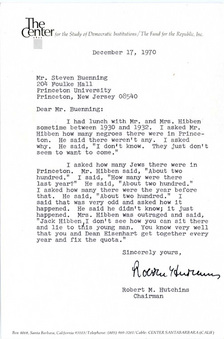“The Princeton of today is not the Princeton of Scott Fitzgerald. And by that I mean you can feel comfortable being Jewish, you can feel comfortable being Asian, you can feel comfortable being African American. And while this might not always have been true (…) it is definitely true today.” The speaker is Erik Ruben ’98 (1:46), one of the students featured in the promotional video below about the Center for Jewish Life, which opened in 1993. Today’s entry takes a brief look at the history of the admission of Jewish students at Princeton since the 1920s.
F. Scott Fitzgerald‘s 1920 debut novel, This Side of Paradise, was set at Princeton and reflected the atmosphere of the eating clubs and of the university itself, which (not to Princeton’s liking) he described as “the pleasantest country club in America.” Fitzgerald wrote his book at a time when some northeastern colleges and universities, particularly in urban areas where many Eastern European Jewish immigrants had settled, perceived they had a “Jewish problem” in that if they admitted too many Jewish students, Protestant middle and upper class students would be driven away. Columbia, which had the largest Jewish enrollment at 40%, was the first to impose a quota in 1921. Princeton, however, always claimed not to use quotas. As late as 1948 Radcliffe Heermance, Princeton’s first director of admissions from 1922 to 1950, vehemently denied a claim that Princeton used a quota to keep Jewish students under 4%. “We’ve never had a quota system, we don’t have a quota system, we will never have a quota system” he told the Daily Princetonian.
 A letter from former University of Chicago president Robert Hutchins, who visited Princeton President John Grier Hibben in the early 1930s, indicated otherwise. Hutchins wrote Princeton senior Steven L. Buenning ’71 In December 1970, as Buenning was seeking information for his senior thesis, a biography about Hibben. In the letter Hutchins recalls how he had asked Hibben about the number of Jewish students at Princeton. According to Hutchins, Hibben claimed that the number just happened, whereupon his wife exclaimed: “Jack Hibben, I don’t see how you can sit there and lie to this young man. You know very well that you and Dean Eisenhart get together every year and fix the quota.”
A letter from former University of Chicago president Robert Hutchins, who visited Princeton President John Grier Hibben in the early 1930s, indicated otherwise. Hutchins wrote Princeton senior Steven L. Buenning ’71 In December 1970, as Buenning was seeking information for his senior thesis, a biography about Hibben. In the letter Hutchins recalls how he had asked Hibben about the number of Jewish students at Princeton. According to Hutchins, Hibben claimed that the number just happened, whereupon his wife exclaimed: “Jack Hibben, I don’t see how you can sit there and lie to this young man. You know very well that you and Dean Eisenhart get together every year and fix the quota.”Heermance limited Jewish enrollment by developing an admission policy that put an emphasis on “character,” which, however subjective, was still regarded as defensible in public. Criteria like “manhood,” “leadership” “participation in athletics” and “home environment and companions” were assessed by using interviews, letters of recommendation, and a social ranking system. A powerful disincentive to even apply was the anti-Semitic reputation of Princeton’s eating clubs, which considered most Jews “unclubbable.”
